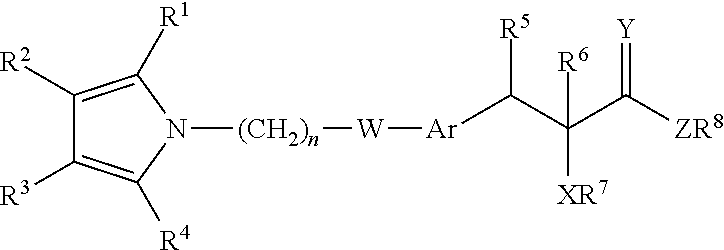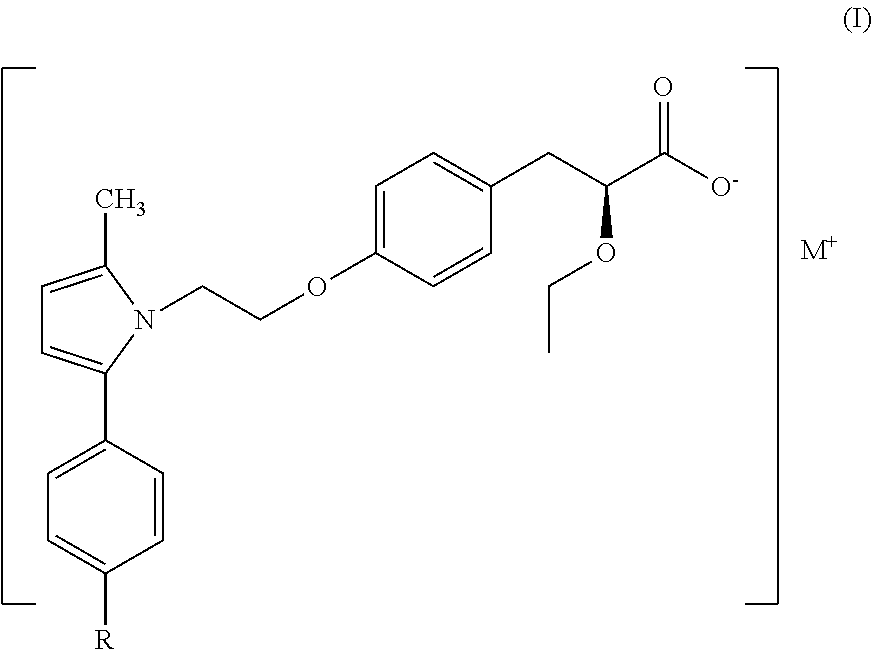Treatment for lipodystrophy
a lipodystrophy and therapeutic compound technology, applied in heterocyclic compound active ingredients, drug compositions, metabolic disorders, etc., can solve the problems of lipodystrophy, lipoatrophy and other metabolic abnormalities, lipohypertrophy, and the molecular basis of ldhiv remains unknown
- Summary
- Abstract
- Description
- Claims
- Application Information
AI Technical Summary
Benefits of technology
Problems solved by technology
Method used
Image
Examples
example 1
Preparation of (S)-α-Ethoxy-4-[2-[-methyl-5-[4-(methylthio)phenyl]-1H-pyrrol-1-yl]ethoxy]benzene-propanoic acid ethyl ester
[0059]In a dry, 5 L round bottom flask 2.1 L toluene was taken under nitrogen. To this 366.1 g ethyl (S)-α-2-ethoxy-3-(4-hydroxyphenyl)propionate was added at room temperature.
[0060]The reaction mixture was stirred under heating, using Dean-stark apparatus, to remove water azeotropically. The reaction mixture was cooled to 50° C. To this was added 319 g anhydrous potassium carbonate and stirred at 90-92° C. for 1 hr. Cooled to 65° C. and added 500 g 2-(2-methyl-5-(4-(methylthio)phenyl)-1H-pyrrol-1-yl)ethyl methanesulfonate and 22 g tetra butyl ammonium bromide. Reaction mixture was heated to 87-92° C. and stirred for 46 hrs. Cooled to 70-75° C., added 1.5 L toluene, charcoalised using 75 g charcoal and cooled to room temperature. Filtrate washed with alkaline solution, washed with water, dried over sodium sulfate and concentrated under vacuum to obtain (5)-α-Eth...
example 2
Preparation of (S)-α-Ethoxy-4-[2-[-methyl-5-[4-(methylthio)phenyl]-1H-pyrrol-1-yl]ethoxy] benzenepropanoic acid magnesium salt
[0062]In a dry, 250 mL round bottom flask 80 mL methanol was taken. To this 20 g (S)-α-ethoxy-4-[2-[-methyl-5-[4-(methylthio)phenyl]-1H-pyrrol-1-yl]ethoxy]benzene-propanoic acid ethyl ester was added at room temperature, under nitrogen. To this 1.89 g sodium hydroxide dissolved in 20 mL water was added and stirred at room temperature for 3 hours to complete hydrolysis. Solvent was removed under reduced pressure. 150 mL water was added to concentrate the material Impurity was removed by solvent washing. To aqueous layer was added 5 g magnesium acetate tetra hydrate (dissolved in 20 mL water) and stirred with for 15 min Sticky material was extracted with dichloromethane and subsequently add n-heptane to precipitate (S)-α-ethoxy-4-[2-[-methyl-5-[4-(methylthio)phenyl]-1H-pyrrol-1-yl]ethoxy]benzenepropanoic acid magnesium salt. Solid was filtered, and dried.
[0063]...
example 9
(S)-α-Ethoxy-4-[2-[-methyl-5-[4-(methylthio)phenyl]-1H-pyrrol-1-yl]ethoxy]benzenepropanoic acid potassium salt
[0066]In a dry, 250 mL round bottom flask 72 mL ethyl acetate was taken. To this 10 g (S)-(−)α-1-phenylethylamine salt of (S)-α-ethoxy-4-[2-[-methyl-5-[4-(methylthio) phenyl]-1H-pyrrol-1-yl]ethoxy]benzene-propanoic acid was added at room temperature and subsequently 50 mL water and 4.8 mL dilute hydrochloric acid (water 1:1:35% HCl ) was added and stirred at room temperature till solid was dissolved. Layer was separated and organic layer was washed with water, dried over sodium sulfate and solvent removed. 9.2 g oily mass obtained. To this was added 50 mL methanol and stirred under nitrogen. To this was added 1.81 g potassium t-butoxide and was stirred at room temperature for 15 min. Solvent removed and added n-Hexane. Again n-hexane was removed and added methanol. Solvent removed under vacuum. Hygroscopic material obtained. Dried it under vacuum to get (S)-α-ethoxy-4-[2-[-m...
PUM
| Property | Measurement | Unit |
|---|---|---|
| circumference | aaaaa | aaaaa |
| waist circumference | aaaaa | aaaaa |
| temperature | aaaaa | aaaaa |
Abstract
Description
Claims
Application Information
 Login to View More
Login to View More - R&D
- Intellectual Property
- Life Sciences
- Materials
- Tech Scout
- Unparalleled Data Quality
- Higher Quality Content
- 60% Fewer Hallucinations
Browse by: Latest US Patents, China's latest patents, Technical Efficacy Thesaurus, Application Domain, Technology Topic, Popular Technical Reports.
© 2025 PatSnap. All rights reserved.Legal|Privacy policy|Modern Slavery Act Transparency Statement|Sitemap|About US| Contact US: help@patsnap.com



